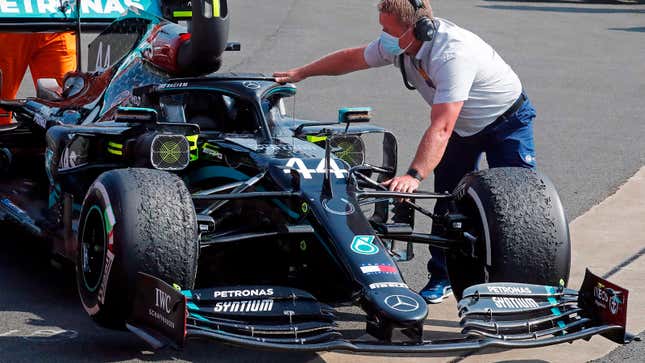
Right now, the most effective tool one driver has to get past another in Formula 1 is pit strategy. The inability for F1 cars to run close alongside each other without suffering huge disturbances in aerodynamic activity — coupled with the general flimsiness of the tires — has produced this obsession with undercuts and overcuts. Commentators will spend half a race trying to verbally work out which strategy is stronger while Amazon makes its flashy graphical predictions. When the pass eventually comes, it’s done with one car in the pit lane. It all feels a bit anticlimactic. But Pirelli, F1's tire manufacturer, could have a strategy to change all that.
Some might argue this isn’t a problem, considering the F1's stratospheric growth as of late. But the move to ground effects signals that the FIA itself knows the inability to make an on-track pass is a shortcoming of the sport. Tires play a role in this balance too of course, and recent comments from Pirelli F1 boss Mario Isola suggest that the new company’s new compound may encourage a shift toward fewer stops, for the good of wheel-to-wheel contention. From Motorsport.com:
While one-stop races are not the preference for F1 chiefs, Pirelli head of F1 and car racing Mario Isola thinks that fewer stops will not influence the show if there are spectacular battles on track.
“I hope we don’t have less strategic variabilities,” he said. “The idea and the way in which we have designed the tyres is to continue to have different strategies, with a mix of one and two stops.
“It is also true that with a new product with less degradation, it is possible that we will have less pitstops and the majority of races could be one stop.
“For me, it is not an issue as long as we have good races and action on track.
“If we have drivers that can push for an overtake, and when overtaking is too easy, it’s not good, it is important that drivers are putting a lot of effort in to overtake. That is exactly what spectators want.
“There is a survey made by F1 on that and the majority of feedback on that is that spectators don’t want easy overtaking, they want action on track and they want fighting.”
Tires that are effectively spent after one or two attempts at a pass don’t promote close racing — they discourage it. A number of F1 drivers have spoken out about this in recent years, and seemingly every other season, Pirelli returns to the table saying it sought out a wider operating window, with tires less prone to overheating, so drivers don’t need to hold back as much. Whether it actually meets those marks or not is sometimes hard to say, but the fact of the matter is, passes are still being done in the pits.
In fairness to Pirelli, it carries a pretty thankless role in the sport. When it’s providing a reasonably reliable product, we don’t tend to hear about it. But when that product spectacularly fails, like during the 2020 British Grand Prix, it becomes public enemy No. 1. Simultaneously, the cars are forever getting heavier and faster, placing more strain on the rubber. It was believed that 2022's breed would be roundly slower than its predecessor, but Pirelli now expects the new cars to outpace 2021 machinery by the end of the coming season.
More from Isola:
“This tyre is designed in a different way, with different targets,” he said. “Drivers are asking for less overheating, and less degradation. They want to push on tyres, they want to fight on track.
“We decided, and we agreed with the FIA, FOM, and the teams, to follow this direction. So we had to design a new profile, a new construction, optimise the footprint, and design a new range of compounds. It is a complete new product with a new approach.”
You’d expect the guy who runs the tire company to gas up how good his tires are, but I’m getting the sense that Pirelli — and, perhaps more importantly, the FIA, which tells Pirelli what to make — are really listening to drivers when they say they want a compound that gives them the confidence to push, rather than a fickle tire to designed to manufacture drama. And if that comes at a consequence of fewer pit stops, well, this is a race, not a chess match. A little on-track action will be good for everyone.